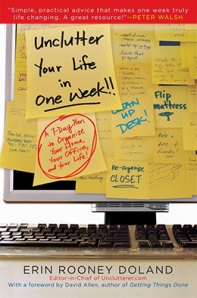
The cover of Erin Rooney Doland's excellent book on organizing.
In case you hadn’t guessed, I am a huge believer in being organized, and in self-improvement in general. Nothing jazzes me quite like a complicated project that promises me a bright, shiny new life of simplicity and ease. On a more practical level, I believe that bipolar folk need to have good systems in place to keep us functioning when depression strikes.Imagine my delight, then, when I read a review recommending Unclutter Your Life in One Week, a summary of wisdom from Erin Rooney Doland’s Unclutterer blog. I ordered it immediately, even though I thought I didn’t really have a tremendous amount of clutter in my home. How could I? I moved into my lovely new condo at the beginning of May, and purged crap madly before packing.
Of course, I do, indeed, have a good deal of clutter at home and at work. Why, my excess beauty supplies would keep a small village clean and preened for a month; my file drawers at work are crammed with outdated papers and office supplies that past data managers have bequeathed upon me, including, to my dismay, transparencies for overheads (which demonstrate that people bored each other well before PowerPoint) and printable labels for floppy disks.
Once I realized how dire the situation had become, I plunged into Doland’s program, and found her advice to be excellent. I would give one caveat: the agenda for each day is crazily ambitious. Unless you want to bog down and get discouraged, I suggest that you set aside two or three weeks for the dramatic cleanup that she recommends. I’m also a believer in incremental rather than dramatic habit change, if only because I’ve committed to so many radical new plans only to discard or simply forget them in the hustle of daily life. Again, I recommend that you allow several months to implement all of Doland’s cool systems.
The book is divided into separate chapters for each day of the week, each one focusing on a different area of the home and office. She begins by telling you how to clean, simplify and organize the area, then gives a system for maintaining your progress and streamlining the activities associated with the area. So, for example, Monday is devoted to tackling your wardrobe at home and your desk at work, and to setting up a “reception station” by your front door that will give you a transitional zone that will keep you from bringing clutter like loose change and unopened mail into your home.
I tackled the wardrobe project on Sunday, and am still working on it sporadically along with my bathroom. It’s Friday and I haven’t even touched the kitchen or living room. Of course, my wardrobe situation had become pretty grim. I love clothes and shoes, and tend to accumulate them willy-nilly without much regard for fit or function. Following her instructions, though, I managed to pare down my holdings and tidy the floor and storage bins. I haven’t yet established a routine for getting dressed, partly because that entails purchasing at least one big item — a full-length mirror. Also, Doland’s goal with getting dressed is to save time — she believes that it should take no more than five minutes — while I actually enjoy putting together the day’s stunning outfit. So I’m modifying her plan to make dressing fun and sensual rather than simply fast.
Doland provides examples of several wardrobe systems that could work, and encourages you to adopt one that you will actually maintain. This is a real advantage over programs like Getting Things Done that tend to seem elaborate, rigid, and overwhelming to us mentally ill folk. Again and again, Doland emphasizes that the goal is productivity, not maintaining a system for the sheer pleasure of being hyper-organized and precise. This is crucial, since I tend to use things like to do lists to procrastinate and engage in obsessive-compulsive checking behavior rather than as productivity tools.
All in all, though there are plenty of other systems out there (many of which I’ve tried), hers ranks in the 90th percentile, certainly. The same is true of her advice on emailing, filing, and running meetings — her systems are certainly not the only ones, and perhaps not the absolute best, but they are an excellent starting point if certain areas of your life have drifted out of control. Doland’s book rises above the competition because she breaks each project down into tiny steps and shows you exactly where to start on what could otherwise be an overwhelming project.
There are two odd omissions: there’s no advice on organizing storage closets (mine is quickly descending into chaos) or junk drawers (ditto). I can happily turn elsewhere for these, though, so it’s no big loss.
Overall, Doland’s book is a valuable organizing tool. Even if I only follow one-seventh of her advice, my quality of life will improve, and I’m all about quality of life. Too, this book showed up in the mail at just the right time: when I was digging out from a depressive episode and becoming discouraged by the disorder around me. I’m ready for some good old-fashioned goal-directed behavior, and Doland’s book has provided structure and encouragement. So buy it and jump in, or store it until you’re neck-deep in clutter and desperate for a cure.
Love to all.
No comments:
Post a Comment